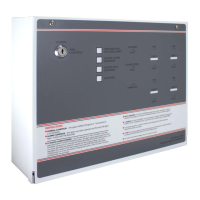FP4E 4 Zone Economy Fire Alarm Control Panel (Part No. FF384-3)
Installation Instructions
FIRE ALARM
ancillaries
1 of 4
Approved Document No. DFU0384011 Rev 2 Draft 4
THIS EQUIPMENT MUST ONLY BE INSTALLED AND MAINTAINED BY A SUITABLY SKILLED AND TECHNICALLY
C
OMPETENT PERSON. THIS EQUIPMENT IS A PIECE OF CLASS 1 EQUIPMENT AND MUST BE EARTHED
.
DO NOT CHANGE ANY PANEL CONNECTIONS WITH THE PANEL’S POWER APPLIED (MAINS OR BATTERY POWER).
DETECTOR
DETECTOR
CALL POINT
CPR
CALL POINT
CPR
DO NOT SPUR -
CIRCUIT NOT MONITORED!
-
+
PANEL ZONE
TERMINALS
DETECTOR DETECTOR
CPR
CALL POINT
CPR
+
-
-+
EMU PANEL MODULE
BF378 or
BF378M
ELECTRONIC MONITORING UNIT (EMU)
CALL POINT
Fig 5
SOUNDERS
+
+
EOLR
+ +
+ +
DO NOT make off
more than 2 circuits
in the panel
EOLR
SOUNDERS
EOLR
EOLR = End of Line Resistor (6k8Ω, 0.25W) - supplied
CPR = Call Point Resistor (470 - 680Ω, 0.5W) - supplied with call point
PANEL ZONE
TERMINALS
PANEL SOUNDER
TERMINALS
TYPICAL ZONE CIRCUIT - Call points wired before detectors
- Detector base diodes not needed.
TYPICAL ZONE CIRCUIT - With mixed order call points and detectors
- Detector bases fitted with continuity diodes and negative connection linked out.
TYPICAL SOUNDER CIRCUITS
Only use polarised sounders!
Remove EOLR from
terminal block and
fit to last detector.
DO NOT SPUR -
CIRCUIT NOT MONITORED!
Remove EOLR from
terminal block(s) and
fit to last sounder.
+
+
-
-
5
6
7
8
INSTALLATION PROCEDURE
All cables must be installed in accordance with all applicable national, regional or local standards. In the UK this is BS 7671 IEE
Wiring Regulations and BS 5839-1, Fire detection and alarm systems for buildings: Code of practice for system design, installation
and maintenance. Fire resistant, screened cable should be used throughout the installation and Mains wiring should be
segregated from extra low voltage field wiring.
For PERMANENTLY CONNECTED equipment, a readily accessible disconnect device shall
be incorporated external to the equipment.
The general requirement for the Mains supply to the panel is fixed wiring, using 3 core
cable, (no less than 1mm
2
and no more than 2.5mm
2
), or a suitable three conductor
system fed from an isolating switched fused spur, fused at 3A. The Mains supply must
be exclusive to the panel.
HINT. As an alternative to a switched
fused spur, a double pole isolating
device (B) may be used in the Mains
feed from the Main Distribution
Board (A) to the panel (C), providing
it meets the appropriate wiring
regulations – see Fig 1.
• Remove the panel’s lid (disconnect attached loom connector).
• Fit the panel’s back box securely to a wall using the mounting holes provided and
suitable screw fixings. Remove required number of knockouts and fill holes with good
quality cable glands – see Fig 2.
• Gland field cables and terminate all screens to the panel.
CAUTION: DO NOT use an insulation tester (Megger) with any electronic devices
connected as the test voltage will totally destroy the devices.
• Test field cables and ensure they are fault-free, i.e. check continuity of cable runs
(including screens).
• Connect external Mains cable to the panel’s fused Mains terminal block (with Mains
isolated) – see Fig 2.
CAUTION: RISK OF EXPLOSION IF BATTERY IS REPLACED BY AN INCORRECT TYPE.
DISPOSE OF USED BATTERIES ACCORDING TO THE INSTRUCTIONS.
Also, if the battery leads are connected in reverse, the battery fuse (F1) will blow
which may damage the panel and invalidate the warranty.
• Position and connect the panel’s two internal 12V sealed lead acid batteries (with
battery supply isolated) – see Fig 3 & Fig 4.
• Connect zone circuits to the panel – see Fig 5.
• Connect sounder circuits to the panel – see Fig 5.
• Connect ancillary connections to the panel.
• Refit the panel’s lid (re-connect loom connector).
• Apply Mains and battery supply to power up the panel.
• The panel should be in normal mode. If not, investigate and rectify any faults
indicated on the panel.
• Finally, test the panel – see pages 2 & 3.
Shorting Link
(supplied)
+
–
12V Battery
Connections
to Panel
+
12V Battery
–
+
12V Battery
–
+
–
12V Battery
Fig 4
Black
Wire
Black
Wire
(supplied)
Red
Wire
Red
Wire
(supplied)
OR
Fig 3
space for batteries
(bottom of back box)
F
ig 2
AA
AA
B
BBBB
B
B
B
B
B
B
B
A = Mounting Holes, B = Cable Knockouts
M
ains cable
L
(LIVE), N(NEUTRAL), (EARTH)
P
ower Rating
A
3A
≥ 1.0mm
2
< 2.5mm
2
B
C
Fig 1

